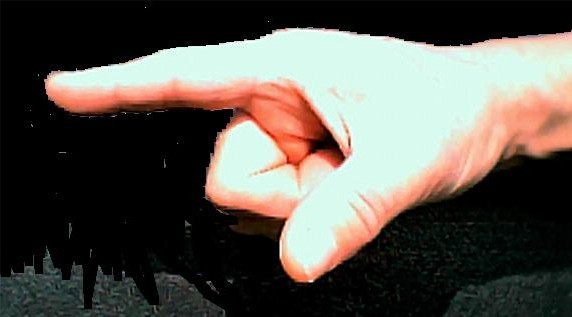

Pointing
(Use Stokoe system to represent hand shapes)
There are specific hand-shapes which are associated with the grasp of objects of particular sizes and shapes
E.g.
Hand-shape
^
'''
G
for grasping tiny objects
= ”I want this tiny thing”
hand- shape Y for grasping small objects
= ”I want this small thing”
hand- shape Z for grasping large objects
= ”I want this big thing”
etc
These are adopted by the hand just before the item is grasped.
As the body and/or arm moves the hand from a distance to the object
the hand shape is different and perhaps more generalized, a whole hand shape, a neutral shape possibly, and for good reason, not included as a meaningful shape in sign languages and so not given a code in a Stokoe type coding system. Let us call this neutral shape ‘N’
= “that thing”
S.l.d. children, (and younger normal children) at first use a whole hand point,
only later do they learn to use a more sophisticated index finger point.
This shape is perhaps the same as shape ‘N’. The child’s early whole hand
point is perhaps directly derived from shape N
So we have lines of development to be used in training the child to
symbolically point
(1) The child whole hand, (hand-shape N), reaches for a distant object
= I want that thing.
Determine something the child likes a lot, e.g. a sweet. Place this at a distance from the child, but in sight.
When the child reaches for the thing we will allow him to get it
---------->
(2) The child whole hand, (hand-shape N), points to a distant object
= ”I want that thing”
When the child whole hand-points to a distant, desired object, e.g. the sweet, we will get the object for the child and give it to him
---------->
(3) The child whole hand, (hand-shape N), points to a distant neutral object
= ”----that thing”
When the child whole hand points to a distant, neutral object, e.g. a ? we
will get the object and ?????
Why should he point, what is the motivation?
---------->
(4) The child index finger points, (hand-shape G), to a distant neutral object
=”----that thing”
When the child index finger points to a distant, neutral object, e.g. a ,
we will get the object and ?????
Why should he point, what is the motivation?
(1a) The child whole hand touch points, (hand-shape N), at a near object
= I want this thing
---------->
(2a) The child whole hand touch points, (hand-shape N), at a near object
=”I want this thing“
---------->
(3a) The child whole hand touch points, (hand-shape N), at a near object
=”----this thing“
---------->
(4a) The child index finger points, (hand-shape G), at a near object
=”----this thing”
We want to bring in here our little experiment in succesfully getting Anna H.
to symbolically whole hand point at a goody in a shallow box, and under a lid
made of a sheet of transparent plastic.
She was not at stage 2a, the neutral hand-shape N became a ? shape and she
just grabbed for the object.